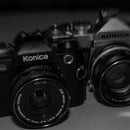Introduction: Simple Coffee Basics
A good cup of coffee does not have to be a trip to the nearest coffee shop.
Step 1: Bean Selection and Grind
Bean roast is DIY or store bought- for the most part skip the pre-ground beans as they are often stale. Fresh grind is often better for the same roast.
Roast varies from light - to dark. A simple light roast with less caffeine, or dark espresso. What to remember is that over-roasted coffee will be bitter and contain less caffeine (heat degradation of proteins and oils that provide flavor).
The grounds are also varied from a fine powder to coarse. No matter the brew method, three factors will be important size/surface area, heat, and pressure/agitation. Coarse grounds have large surface area and needs less heat but more agitation for brew. Finer coffee grounds, such as espresso needs more heat/pressure because of small surface area.
Step 2: French Press
French press is simple way to brew coffee or tea.This is easiest to start a good breakfast as when you know the timing and amount you just auto-pilot heat hot water, brew and press.
Step 3: Grind and Additives
Coarse ground beans works best.
Step 4: Add Hot Water
Water should be near boiling, too hot and it will burn your coffee. Too Cold and you get a weak brew.
Step 5: Brew Time
So many factors change the brew time (temp * coarseness * pressure), but usually 5-10 min for a good brew with water just starting to boil. If you wait longer it would be a good strong brew, however it may get cold. After the grinds start to sink push them down so they are submerged. Judge by color and temp to know when you want it strong enough.
Step 6: Press and Pour
This should be simple right. Well it is just don't rush. if you press or pour quickly you will force more grounds into your brew. Also leave the last remnants alone, it will be filled with coarse grounds and is the portion that most earns the bad rap for gritty coffee.
Step 7: Traditional Espresso
The stove-top percolator is a classic way to brew espresso coffee. Simple design and then some finesse to not burn the coffee. There are three parts, the water reservoir, hopper for the grounds, and the pot it percolates into.
In the bottom fill with water below the pressure release valve.
The grounds you can pack tightly to the fist line, or loose to the top. A spoon is all you need here.
Then just assemble and screw together.
Step 8: Percolate
Percolate by slowly bringing to a boil. Too long or too hot will burn the coffee and make it bitter. So medium to low heat with gas is right. You need to experiment here.
Step 9: The Boil and Done
The espresso will drip into the top and have a bit of foam. When it gurgles it is almost done. when flow sputters remove from heat.
you can add sugar and milk now.
*Bonus if you bring some milk just below a boil and whip with a fork or mixer you can make latte/cappuccino.
Step 10: Fin
Enjoy your Coffee!













